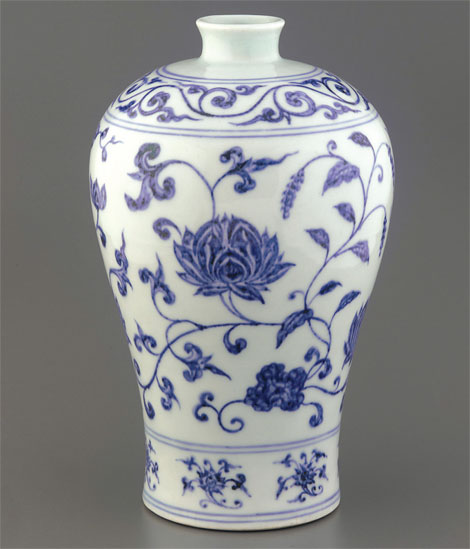Smithsonians' digital project gives access to Asian artwork
Starting today, the Smithsonian Institution's two museums of Asian art will release their entire collections online.
|
This porcelain shape from the Yongle period (1403-1424) is called meiping and is available online for public viewing from the Smithsonian's two museums of Asian art. Provided to China Daily |
This means that a Chinese porcelain vase from the Yongle period (1403-1424) that hasn't been on public display for at least nine years will be available for public viewing.
The porcelain shape is called a meiping in Chinese. "The name means a vase that is perfect for holding a single branch of a flowering plum, which is one of the favorite blossoming trees in China," said Jan Stuart, the Melvin R. Seiden Curator of Chinese art at both the Freer Gallery of Art and the Arthur M. Sackler Gallery in Washington.
"We are the first Smithsonian museums to digitize theircollections. This is a great opportunity for scholars and researchers as well as virtual visitors to have 24/7 access to our impressive collection," Courtney O'Callaghan, chief digital officer told China Daily. The free public resource, called "Open F/S", is available at open.asia.si.edu.
By digitizing the collection, O'Callaghan and the staff at the museum have taken photographic images of every object (more than 40,000) and uploaded them and descriptions into a digital-asset management system. Over 90 percent of the images will have high-resolution quality.
Because of space and other limitations, much of the museums' collection isn't on public display. "The public will now have unlimited access to those objects," said O'Callaghan.
O'Callaghan said the museums are not concerned that the online access will affect attendance. "We are hoping that it will actually lead to an increase in attendance," she said. "We believe that by removing financial and physical limitations, we can actually increase interest in the museums."
In addition to holding a branch, vessels like the porcelain vase were used as wine bottles. "It is painted with abstract Locust flowers and plant stalks with grain. In Chinese you can make a play on these words to say may you have peace year after year," said Stuart.
"It's in perfect condition and the cobalt pigment used was probably imported from Iran."
O'Callaghan said this project has been in progress for the last 15 years. "We were the first Smithsonian museum to go digital 15 years ago so this is really a natural extension of that," she said, adding that the project is totally funded in-house by the museums.
"As someone who studies and loves art, I am thrilled that a person in China or in New York will have access to this," said Stuart.
paulwelitzkin@chinadailyusa.com





















